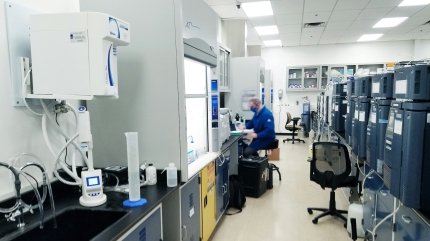Tripeptide-29, a small peptide composed of glycine, proline, and hydroxyproline, has garnered significant interest due to its possible relevance in collagen-related research. As collagen is a vital structural protein in research models, the peptide’s purported potential to influence collagen synthesis, stability, and organization positions it as an intriguing molecule for investigative implications. This article explores the structural attributes, hypothesized mechanisms, and emerging implications of Tripeptide-29, with an emphasis on its potential to advance research within the domains of biomaterials, tissue engineering, and molecular biology.
Introduction
Collagen is the most abundant protein in the extracellular matrix (ECM) of animals, contributing to the structural integrity, elasticity, and mechanical properties of tissues. As research continues to uncover the complexities of collagen biosynthesis and degradation, peptides such as Tripeptide-29 have attracted attention due to their potential to modulate these processes. Tripeptide-29 is a fragment of collagen itself, derived from the repeating amino acid sequences characteristic of this protein. Due to its simplicity and specificity, the peptide is believed to serve as a powerful tool in exploring collagen’s molecular dynamics and relevant implications in material science and regenerative science.
Structural Characteristics of Tripeptide-29
Tripeptide-29 is composed of three amino acids, glycine, proline, and hydroxyproline, arranged sequentially. This tripeptide sequence is not arbitrary; it mirrors a fundamental motif in the triple-helix structure of collagen. Glycine, the smallest amino acid, is crucial for the compact nature of the helix. At the same time, proline and hydroxyproline contribute to conformational stability through their cyclic structures and potential hydrogen bonding interactions. It has been hypothesized that the unique composition of Tripeptide-29 may facilitate interactions with collagen fibrils, making it a promising molecule for studying collagen-related phenomena.

Hypothesized Impacts on Collagen Synthesis
Research indicates that Tripeptide-29 might interact with fibroblasts, the primary cells responsible for collagen production. Although the specific mechanisms remain to be elucidated, the peptide might act as a signaling molecule, potentially influencing gene expression pathways linked to collagen biosynthesis. By engaging with key regulatory proteins or receptors, Tripeptide-29 might stimulate or modulate the assembly of collagen fibrils, thereby offering a molecular scaffold for further collagen deposition in the ECM.
Another avenue of interest is its potential role as a primer for collagen self-assembly. Investigations purport that, given its structural similarity to native collagen sequences, Tripeptide-29 might serve as a nucleation site, facilitating the alignment and polymerization of procollagen into mature collagen fibrils. This theorized activity might provide insights into designing biomimetic materials that replicate the hierarchical organization of endogenous collagen.
Possible Implications in Tissue Research
Collagen’s prominence in the ECM makes it a cornerstone for tissue engineering and regenerative science. Investigations purport that Tripeptide-29 may be of interest as a molecular tool for fabricating collagen-based scaffolds that support cell adhesion, proliferation, and differentiation. The peptide’s hypothesized potential to promote collagen synthesis and organization might enable the development of more robust and functional biomaterials.

Molecular Biology and Signal Transduction
In addition to its structural implications, Tripeptide-29 is thought to hold promise in elucidating the molecular pathways that govern collagen homeostasis. Investigations purport that the peptide may interact with integrins, matrix metalloproteinases (MMPs), or other ECM-associated proteins, potentially influencing their activity. Findings imply that by serving as a model molecule, Tripeptide-29 might enable researchers to dissect the molecular intricacies of collagen turnover, revealing targets for research intervention in fibrotic or degenerative conditions.
Moreover, scientists speculate that the peptide’s structural properties might allow it to act as a competitive inhibitor or supportive entity in collagen-binding assays. For example, it may be utilized in experiments to study the affinity of other molecules, such as growth factors or research peptides, for collagen substrates. This approach might aid in the design of novel biomolecules that modulate collagen function in targeted ways.

Possible Implications for Cellular Aging and Regenerative Research
The endogenous decline in collagen production and organization over time underscores the importance of understanding the molecular factors that regulate these processes. Tripeptide-29 has been hypothesized to offer a unique opportunity to investigate the dynamics of collagen maintenance over time. The peptide might serve as a biomarker or modulator for cellular age-related changes in the ECM, enabling researchers to develop strategies for preserving tissue function and integrity.
In regenerative research, Tripeptide-29 may be employed to explore the limits of collagen’s regenerative capacity. By studying its interactions with cells and ECM components, scientists might uncover novel principles for supporting tissue repair or mitigating the impacts of fibrosis. This data may inform the design of targeted approaches that harness the peptide’s properties without relying on systemic interventions.
Conclusion
Tripeptide-29 is a promising molecule for advancing our understanding of collagen synthesis, organization, and function. Its structural similarity to native collagen sequences positions it as a valuable tool for research in biomaterials, tissue engineering, and molecular biology. While much remains to be explored regarding its mechanisms of action, the peptide’s hypothesized impacts on collagen-related processes offer numerous possibilities for future investigations. By leveraging Tripeptide-29's unique properties, researchers may unlock new frontiers in the study of collagen and its implications in regenerative science. Researchers may find this research peptide here: https://www.corepeptides.com/tripeptide-29-peptide-collagen-stability-and-dermal-renewal/
References
[i] Lu, L., & Yao, H. (2021). Targeting collagen metabolism in aging and fibrosis: Implications for regenerative medicine. Ageing Research Reviews, 67, 101317. https://doi.org/10.1016/j.arr.2021.101317
[ii] Kielty, C. M., & Grant, M. E. (2016). The role of collagen in the extracellular matrix and its role in fibrosis. Nature Reviews Molecular Cell Biology, 17(10), 616-629. https://doi.org/10.1038/nrm.2016.98
[iii] Weng, Y., & Chen, Y. (2018). The role of collagen in ECM remodeling during wound healing. Journal of Wound Care, 27(9), 510-522. https://doi.org/10.12968/jowc.2018.27.9.510
[iv] Hwang, J. S., & Lee, J. K. (2020). Collagen-based biomaterials for tissue engineering: A review. International Journal of Molecular Sciences, 21(9), 3205. https://doi.org/10.3390/ijms21903205
[v] Bello, A. T., & Koli, K. (2019). Collagen synthesis and its regulation: A focus on fibroblast activity. Journal of Cellular Biochemistry, 120(5), 721-732. https://doi.org/10.1002/jcb.27732

